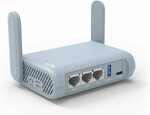One of the ways the Beryl is being marketed is being an “an advanced version of our best-seller, Slate (GL-AR750S)”.We know a few people have already bought the Slate off Ozbargain so the question is does it replace the Slate? In my mind it’s both “yes” and “no”
There’s a number of ways that the Slate is still relevant and useful especially when used as a travel router.
What’s been improved in the Beryl over the Slate?
AC1300 versus AC750
USB 3 versus USB 2
VPN speeds better 21/91Mbps versus 17/68Mbps (OpenVPN/Wireguard)
USB-C versus USB-Micro
IPV6 support
Where is Slate “better” for travel over the Beryl
Lighter 86g versus 184g
Smaller 100mm X 68mm X 24mm versus 118 x 85 x 30mm
Supports EAP WiFi networks
Only requires 5V/2A versus 5V/3A (better run life when attached to a portable power source (notebook/powerbank) while truly mobile)
Cheaper :slight_smile:
So in my head, if you want a truly portable router to take out to the cafe and in your kit bag, then the Slate still holds some advantages over the Beryl. If you’re going to setup in a hotel room for a week or so, the Beryl’s probably a better option (if you can live with the additional size and weight getting there). You need to weigh up the better functions of the Beryl against the larger size as your travel router. That being said for a small apartment or as a repeater/extender, or as a VPN client then this little discrete unit will work as a “home” router really well and look good.
Just my first quick thoughts and as always YMMV
Still another Gl-iNet router that performs well above it’s size and does everything a big router can accomplish in a much smaller form factor. Of course we can’t forget the flexibility offered by it running OpenWRT compared to other commercial routers.
As per normal, the Beryl supports all the functions of the Gl.iNet routers (VPN Server/Client/TOR/DNS over TLS etc) and has the handy Gl.iNet interface wrapped over the top of OpenWRT.
Specification
CPU: MT7621A, Dual-Core @880MHz
Memory / Storage: DDR3L 256MB / FLASH 32MB
Wi-Fi Speed: 2.4GHz(400Mbps), 5GHz(867Mbps)
Ethernet Port: 3 x 10/100/1000Mbps auto-negotiation
Antennas: 2 x undetachable external Wi-Fi antennas
Power Input: Type-C, 5V/3A
Working Temperature: 0 ~ 40°C (32 ~ 104°F)
Storage Temperature: -20 ~ 70°C (-4 ~ 158°F)
Dimension / Weight: 118 x 85 x 30mm, 184g
Some quick thoughts, ideas, comments (in no particular order)
*If you use as a WISP repeater then you repeat on one band and LAN on the other for "full" bandwidth (unlike a single band unit like the Mango)
*Supports out of the box OpenVPN and Wireguard Server and Client and with the latest firmware TOR client.
*VPN access on/off can be controlled by a physical on/off switch.
*Via the web interface you can switch VPNs. I have a Wireguard client back to my home router server for security and Australian internet access but also have 3 OpenVPN countries setup on Nord/Pure for geographical VPN. It's easy as dragging a CFG file into the interface to setup and the web interface lets you change between them
*One thing that isn't mentioned is the security implications on connecting to an open network. Using this you end up with your own firewalled, subnetted network (This is why Chromecast will work on a hotel captive portal network)
*While default is 1 WAN and 2 LAN ethernet, if you are using WISP you can change to 3 LAN ports
*Because it's OpenWRT based you can add any of the packages out of the OpenWRT repository. I have run VPNs, AdBlock, Transmission Torrent downloads to the USB stick connected etc
*It can also be used as an AP or repeater. Handy because of it's size
*5V/3A means you can run off a appropriate phone power pack, modern PC/Tablet USB port, Car 5V adapter or powerbanks.
*Full LUCI interface can still be accessed outside of the Gl.iNet wrapper
*If you're on holidays with the family you can configure all your devices to attach to the Beryl and as you move from free WiFi to free Wifi you don't have to reconnect all their devices just the Slate once.
*You can put a USB stick on it to share music/movies/photos (or in a car, or on a plane) even without an internet connection.
*You can connect a 4G USB Dongle to it (as long as it's supported by OpenWRT) or USB tether you mobile to it and use as a router to share the LTE.
*Because the router presents itself as a device to the network, and all connected devices to the Beryl present as the Beryl (if that makes sense), gets around restrictive WiFi networks where you can only have a limited number of devices. Useful too if you're paying for per device.
*It's a great small and versatile unit. It won't suit everyone or every circumstance, but if you've got a use for it they're a great jigger :)



 CamelCamelCamel
CamelCamelCamel

Any news on the upcoming GL-A1300 or GL-AXT1800? Been looking for a travel router but I might hold off if the new ones are going to be better.